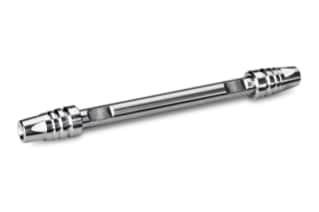
|
Chemistry |
C8 |
|
Separation Mode |
Reversed Phase |
|
Particle Substrate |
Hybrid |
|
pH Range Min |
1 pH |
|
pH Range Max |
12 pH |
|
Maximum Pressure |
10000 psi (690 Bar) |
|
Endcapped |
Yes |
|
Silanol Activity |
Low |
|
Particle Shape |
Spherical |
|
Particle Size |
2.5 µm |
|
Endfitting Type |
Parker-style |
|
Pore Size |
130 Å |
|
Format |
Column |
|
Surface Area |
185 |
|
System |
UPLC, UHPLC |
|
Particle Technology |
BEH |
|
USP Classification |
L7 |
|
Inner Diameter |
4.6 mm |
|
Length |
100 mm |
|
Carbon Load |
13 % |
|
UNSPSC |
41115709 |
|
Brand |
XBridge |
|
Product Type |
Columns |
|
Units per Package |
1 pk |

XBridge BEH C8 Column, 130Å, 2.5 µm, 4.6 mm X 100 mm, 1/pk
In comparison to the XBridge BEH C18 sorbent, the XBridge BEH C8 sorbent is less retentive. The speed that a less retentive column offers may be preferred by anyone designing procedures while also enhancing peak shape and chromatographic performance. You can use the tri-functionally bonded sorbent over the largest pH range (1–12), with the best low pH stability and with the least amount of column bleed.
You may quickly create a distinctive LC/MS assay or quality control method with the XBridge BEH C8 Column while maximizing efficiency. The analytical column offers increased pH stability and a longer column life. Improved column reliability will also help you because it will result in more robust assays. The column is the perfect piece of lab equipment since it gives you unmatched peak form and capacity while allowing you to maximize particle efficiency.
Unmatched repeatability is provided by the XBridge BEH C8 Column. The column's purpose is to maintain and provide repeatability for the same product from batch to batch and year to year. This is due to Waters' opinion that reproducible column performance is one of the most crucial elements for procedure reliability. The XBridge BEH C8 Column is extensively tested from raw material characterization to final batch analysis to guarantee that you only receive the best lab equipment.
The XBridge BEH C8 Column was designed with high efficiency, symmetrical peak shape, and increased pH stability across a wide pH range in mind. Scientists rely on the column chemistry of the XBridge BEH C8 Column to deliver consistently reliable results for even the most difficult research.
You may also shop for lab equipment on our website and get in touch with a member of our global support staff if you have any queries. You may also be interested in XBridge BEH C8 XP VanGuard Cartridge, 130Å, 2.5 µm, 3.9 mm X 5 mm, 3/pk; By eliminating particle pollution from the mobile phase stream, XBridge BEH C8 VanGuard Cartridges are utilized to increase analytical column lifetime and performance. All 4.6 mm I.D. XBridge BEH C8 analytical columns with 2.5 µm sorbent particles are protected by this cartridge.
How Are Temperature Changes Affecting Liquid Chromatography?
Analytes are either dissolved in the mobile phase of chromatography or adsorbed to the stationary phase of the column in a series of equilibrium processes. When the temperature is higher, the analytes transition between the mobile and stationary phases more quickly. Hence, the process is sped up by higher temperatures.